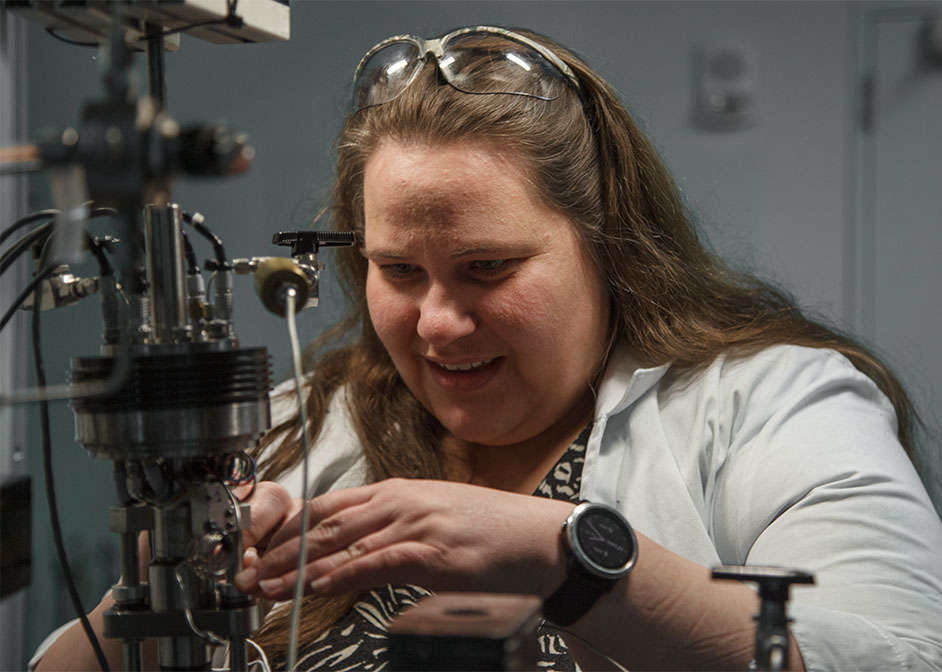Geophysics Ph.D. Student’s Research is a Game Changer for Oil and Gas Exploration
Larkin Spires Targets Mysteries in Organic-Rich Shales
Organic-rich shales, hidden layers beneath the Earth's surface, hold secrets vital to our energy needs. Understanding their behavior is key for safe and efficient resource extraction.

Larkin Spires, a geophysics Ph.D. student in the Department of Earth and Atmospheric Sciences at the University of Houston, is delving into the intricate world of shale mechanics.
“The research we’re doing will help the oil and gas industry save money because it can help them de-risk a prospective drilling area while promoting greater efficiency,” said Spires.
Think of Spires as a detective piecing together clues to solve a mystery. By improving our understanding of shale’s durability when it contains organic matter, she's promoting better predictions about how shale will behave deep underground.
Spires’ research findings were published in the journal Nature Scientific Reports. The work focuses on refining mathematical models to better capture the behavior of organic-rich shales that lie underground.
“There’s a theory to explain the effect of different fluids in rock, but it has not been verified as applicable for organic shales” said John Castagna, Margaret S. and Robert E. Sheriff Endowed Faculty Chair in Applied Seismology at the UH College of Natural Sciences and Mathematics. “We want to try to predict the different fluids in the rock remotely from the surface. This can be important for oil and gas operations as well as carbon storage.”
Castagna is Spires’ faculty advisor and collaborated with her on the study.
Using Artificial Material
Spires, who was named to the inaugural cohort of UH-Chevron Energy Graduate Fellows, is taking a different research approach. While other scientists take small samples of shale and squish them under different pressures, Spires is using artificial material for the same purpose.
“I use 3-D print material that is basically a lab rat for geology so I can control the porosity and flow of fluid through it,” said Spires.
Spires created a rock physics model that allows for testing of the artificial rocks she created.
The tests uncovered details about each object’s solid modulus, the measure of a material's resistance to being squished or stretched. It's like the firmness of a mattress. Some are soft and bouncy, while others are firm and unyielding.
“Solid modulus tells us how stiff a material is, which is vital when dealing with underground layers like shale,” said Spires.
According to Spires, knowing the solid modulus of organic-rich shales is essential for oil and gas extraction. It helps engineers design more streamlined techniques for drilling and fracking.
Mathematical Models Examined
Spires’ study examined models using Gassmann’s equation and the Brown-Korringa equation for fluid substitution.
Gassmann’s equation is used to predict how rocks with different fluid content behave when you change things like pressure, temperature and volume. It can be compared with a rulebook that helps researchers understand how the rocks will act under different conditions. Think of it as predicting how a balloon will change size if you squish it or heat it up.
“Gassmann’s equation, which has been used for 60 years, works well in conventional oil and gas situations with similar mineral components, but it does not work well in fracking,” said Spires. “That’s because fracking often involves shale with organic constituents much softer than other minerals and Gassman theory breaks down.”
Fracking, the common term for hydraulic fracturing, is a process of injecting water, sand and possibly chemicals into a well to release oil and gas reserves located underground.
Spires’ model is based on observations, rather than only theories, to help determine the density and stiffness of rocks underneath the surface by considering their mineral composition.
“The model using the Brown-Korringa equation produced a lower level of error at higher organic content while being a better fit for the data,” said Spires. “With that in mind, my goal is for this model to become one that can provide a more reliable way to explore shale with highly compressible organic matter.”
- Chris Guillory, College of Natural Sciences and Mathematics
March 21, 2024